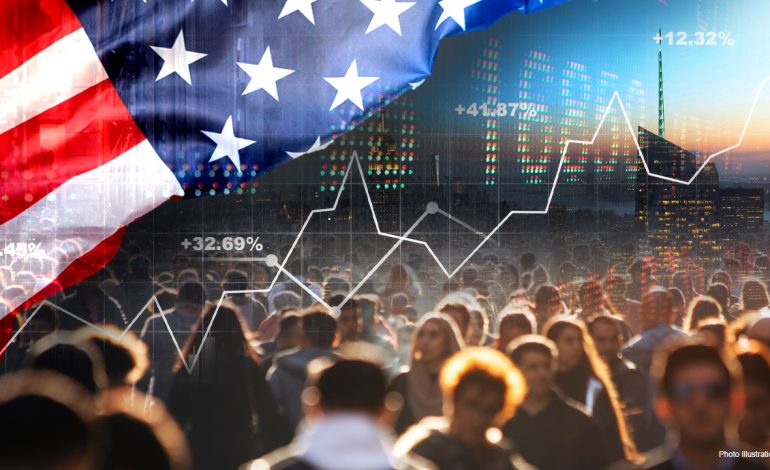US stock futures held their ground Wednesday following two consecutive days of gains, as investors weighed mixed signals from labor market data against ongoing trade uncertainties and policy shifts.
The S&P 500 futures were little changed, preserving the benchmark’s recent advance — its first back-to-back gain since mid-May.
Global equity markets reflected renewed optimism. MSCI’s global stock index touched an all-time high, supported by gains across both European and Asian markets. In currency markets, the US dollar dipped 0.1%, while Treasury yields dropped sharply as investors absorbed signs of weakening private-sector job creation.
The optimism was initially fueled by earlier-than-expected strength in US employment data. However, Wednesday’s release of the ADP employment report tempered that view. The private sector added just 37,000 jobs in May, marking the slowest growth since March 2023 and falling well short of economists’ expectations. The reading follows April’s downwardly revised 60,000 jobs and a projected increase of 110,000.
This data preceded Friday’s nonfarm payrolls report from the Bureau of Labor Statistics, which will offer a broader view of labor market conditions. Investors are watching closely for signs of economic resilience amid escalating tariffs and rising uncertainty around US-China trade relations.
Meanwhile, services data added to the cautious sentiment. The ISM’s index of US services fell to 49.9 in May, slipping below the 50-mark that separates expansion from contraction. New orders, production, and inventories all weakened, pointing to slower momentum in a key sector of the economy.
Despite these warning signs, equity markets remained stable. Analysts attributed the resilience to a confluence of factors, including optimism around future rate cuts and global political clarity. In South Korea, for example, the Kospi Index rose 2.7% after the swearing-in of a new president ended a prolonged period of political uncertainty, boosting investor sentiment across Asia.
“Optimism brewed on Wall Street overnight after upbeat job data and was amplified in Asia by Korea’s post-election clarity,” said Hebe Chen of Vantage Markets. “Together, they’ve handed investors a solid reason to stay risk-on.”
The ADP report triggered a notable reaction in the bond market. Yields on US Treasuries fell across the curve, with the 10-year yield dropping more than 10 basis points to around 4.36%. The 2-year and 30-year yields also sank, suggesting that investors increasingly expect the Federal Reserve to respond with interest rate cuts if labor market conditions continue to deteriorate.
President Donald Trump renewed his calls for the Fed to cut rates, reportedly expressing frustration over its policy stance during a recent meeting with Chair Jerome Powell. The Fed’s Beige Book, set for release later Wednesday, could offer further insights into how regional economic conditions are evolving amid trade policy changes.
Trade dynamics remain a key market driver. US tariffs on imported steel and aluminum doubled to 50% on Wednesday, potentially adding pressure to domestic industries reliant on those materials. The administration argues that the move will safeguard US production, though critics warn it may raise input costs and hurt competitiveness.
In a parallel development, China’s restrictions on exports of rare earth elements — critical to technologies ranging from electric vehicles to defense systems — continue to ripple through global supply chains. While some curbs were temporarily lifted as part of a trade de-escalation effort, US officials have accused China of slow-walking the implementation of those changes.
Among individual stocks, Remy Cointreau withdrew its long-term sales guidance, citing trade friction and sluggish US market recovery. Shares of cybersecurity firm CrowdStrike fell after its revenue forecast missed expectations. Meanwhile, Brookfield Asset Management announced plans to invest nearly $10 billion in AI infrastructure in Sweden, and betting game developer Hacksaw AB signaled plans for a Stockholm IPO as the European market reopens to listings.
Investors now await further data, including the Federal Reserve’s Beige Book and Friday’s US jobs report, for a clearer picture of the economic trajectory. Amid geopolitical shifts and evolving trade policies, markets appear to be balancing cautious optimism with growing recognition of downside risks.
In the short term, attention remains on whether economic momentum — especially in the labor market — can withstand continued external pressures.
As Moritz Kraemer of LBBW Bank noted on Bloomberg TV, “We’re not seeing the shocks yet… This is just deferred.”
Bloomberg, CNBC, and US News & World Report contributed to this report.










The latest news in your social feeds
Subscribe to our social media platforms to stay tuned